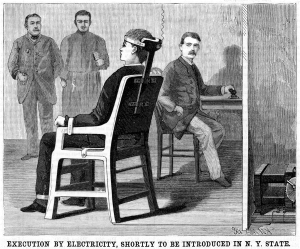The topic of death is one that will never cease to generate interest, and no one is more interesting than the man who is sanctioned by the state to administer death. He is put into such a unique position; a killer of killers, a righter-of-wrongs so to speak.
How does someone reconcile their duties with what they know in their heart? Are these men really servants of justice, or are they no better than the men they send on to the next life? Like so much of humanity, the answer often lies somewhere between two of the extremes. What follows is the story of ten executioners who struggled to cope (or didn’t) with the massive burden of responsibility that executioners carry.
10. Edwin Davis
As civilization has moved ever forward, we have shed many of the barbaric practices of the past. Practices such as killing undesirables by brutally hanging them. Instead, we started brutally killing them with electricity. Hanging is far from pleasant, instead of the intended broken neck, convicts often would asphyxiate—a slow and painful process that could take up to half an hour.
The state of New York saw its first execution by electrocution on August 6, 1890. Edwin Davis was the executioner charged with ending the life of William Kemmler, a convicted murder. Both men understood the significance of the event, and Kemmler is reported as hamming up his fifteen minutes of fame with a wild stage bow.
The thing about new technology is that it doesn’t always work on the first try. The first pull of the switch administered a supposedly lethal surge lasting 17 seconds. When the circuit was broken, Kemmler was still alive and trying to breathe. Not to be discouraged, Davis again pulled the switch, though the second shock went on for more than a few minutes. Apparently, the effects of the electrocution were so horrible that a reporter who was present fainted, and witnesses gagged at the smell of Kemmler’s charred flesh.
After a 24 year career, Davis retired in 1914. From his time as a ‘prison electrician’ (a misleadingly mundane job title by today’s standards) Davis administered lethal doses of electricity to more than 300 people in multiple states. While some men who dealt death to convicts had trouble sleeping at night, Davis was a different sort of man. He boasted about his work and was even the builder of the first electric chair back in 1890.
9. John Hulbert
Edwin Davis was an accomplished executioner with a hefty resume of over 300 electrocutions, and he was boastful until the end. His protégé, a man named John W. Hulbert Jr., was less enamored with the grisly business of killing people. Hulbert took over for Davis when he retired, and retired himself in 1926.
During his career he was responsible for the deaths of over 140 convicts, but he never shared his mentor’s enthusiasm. When asked about his retirement, Hulbert said “I got tired of killing people.” The stress associated with his job was more than he bargained for, and his fears got the best of him.
When he went out, Hulbert was armed with a gun for fear of reprisals from friends or relatives of the convicts he had executed—remember there were more than 140. He built up a routine to protect himself in other ways too. After he performed his obligation to the state and to justice he would dine at the same restaurant. He would always order the same meal and he relied on one single waiter who was generously compensated. Hulbert lived in constant fear that his food would be poisoned as a retribution for a death caused at his hands.
In the end, it turned out that he had nothing to fear from strangers. It was the stress of his grim profession and perhaps some imbalance within in him that ended John Hulbert’s life. In 1929, he went down into his basement and took his own life with a gun.
8. Robert Elliott
Next in the line of executioner succession is a man named Robert Elliott. Like his predecessor, Elliott was a private and worried man who attempted to conceal his identity for fear of the repercussions associated with being a state sanctioned killer. Despite his attempts, his name became public less than a year after he began his career and he became the recipient of a host of threatening letters. The worst of these was a bomb hurled at his house. While the front porch was destroyed Elliott was unharmed.
Topping the career of Edwin Davis he successfully executed 386 convicts on behalf of the state and of justice. While he was officially employed in New York, he also carried out executions in several other states. While Hulbert’s career slowly ate away at his insides and began to unravel his psyche, Elliot was apparently unfazed by the tremendous weight of his position. It wasn’t until he eventually penned his memoirs that people learned his true feelings on the topic of capital punishment.
Elliott went to church every Sunday, and his spirituality can be found in his assessment of the death penalty. Elliott firmly believed that justice and revenge should be carried out by God, not by men. The way Elliott saw things, he carried out his duties to ensure that at the very least the condemned men whose lives he took did not suffer.
7. Joseph Francel
Like Elliott and Hulbert before him, Joseph Francel resisted the scrutiny of the public eye as an executioner. He worked in Sing Sing from 1939 to 1953, and try as he might, his involvement in the sentences of several high profile convicts.
Described as a soft spoken man from the Catskill Mountains, a rural and mountainous region in upstate New York, Francel was responsible for the executions of 137 convicted men and women. Several famous mobsters met their end when he pulled the switch, two of whom were the Rosenbergs. Julius and Ethel Rosenberg met the electric chair through a conviction that they were stealing atomic secrets for sale to the Soviets. While the execution of Julius Rosenberg went smoothly, his wife required a second dose of electricity. This raised eyebrows, and concerns were raised that she died inside the Jewish Sabbath.
Citing poor pay and friction with prison administration, Francel resigned. Records indicate that his compensation per execution was competitive: he was paid $150 per electrocuted convict.
6. James Van Hise
While the first electrocution occurred in New York in the year 1890, it wasn’t until 1907 that the first state sanctioned execution involving an electric chair occurred in New Jersey. It was turn of the century execution heavy hitter Edwin Davis that pulled the switch both times. Davis’ execution in the Trenton state prison was the first of many, but in other parts of New Jersey, the state retained a sour veteran hangman by the name of James Van Hise.
After hanging 250 convicts throughout the course of his career, Van Hise was sitting in the hot seat (so to speak) for replacement. The modern world was looking down on the barbarism that accompanied hanging and instead sought the clean and humane approach of death by electrocution. More electrocutions meant less hangings, and while Edwin Davis would go on to make more money, Van Hise was facing replacement.
To remedy the often unreliable and grotesquely inhumane act of hanging—and to prevent his trade from fading into history—Van Hise decided that a counter weight that would pull upwards on the victim’s neck was a more reliable method that relying on gravity and the drop to break a convict’s neck.
The first time Van Hise was afforded an opportunity to test out his new invention he was in one of his characteristically unpleasant moods. He hurried convicted wife-killer Edwin Tapley onto the gallows and cut his last words short with the traditional black execution hood. The weighted system was an unmitigated failure. It took nearly fifteen minutes for Tapley to expire, and Van Hise never lived down his backfired attempt to build a better mouse trap.




